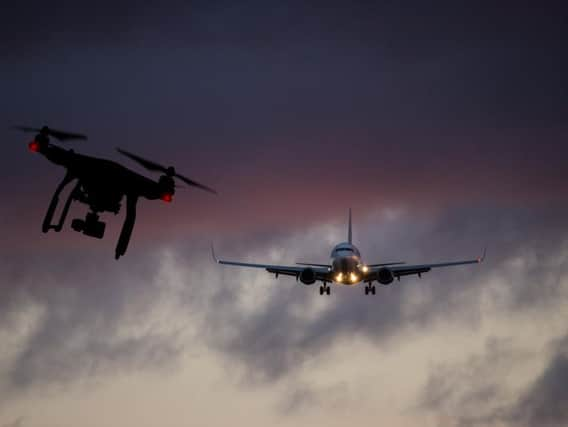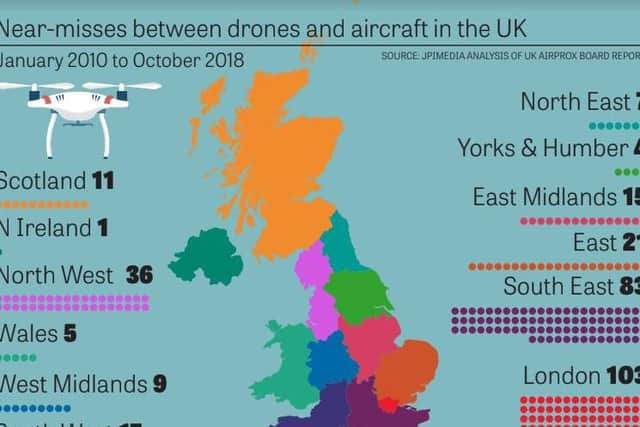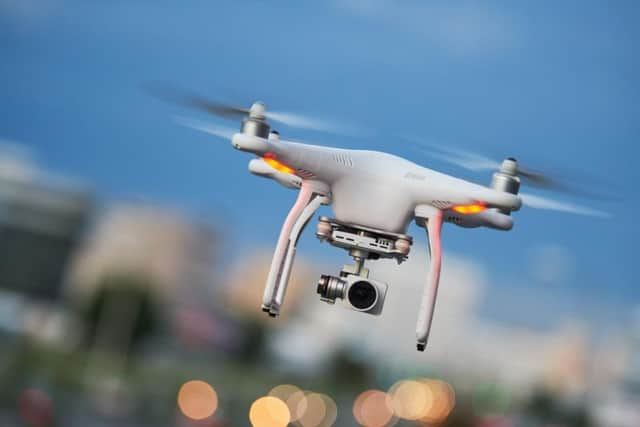Figures reveal deadly danger of drones in our skies


This includes two near-accidents in Lancashire, one close to Blackpool Airport and one near Chorley, 19 near Manchester and eight near Liverpool.
Drone sightings brought 36 hours of chaos to Gatwick Airport in the run-up to Christmas, with runways closed and 1,000 flights affected in what police described as a “deliberate act” of disruption.
Advertisement
Hide AdAdvertisement
Hide AdHeathrow was also forced to ground flights after drone sightings in early January.


But pilots had begun to report narrowly missing drones in the sky from 2010 onwards, analysis of hundreds of official reports shows.
The board, which examines near-misses, noted in one report that “the short battery life of drones means that, with a typical flying time of approximately 15 minutes, it is difficult for the police to respond and catch drone operators flouting the regulations”.
On July 30, it became illegal for any drone to fly above 400ft.
Advertisement
Hide AdAdvertisement
Hide AdDespite this, more than 20 near-misses above this height have been reported since the law took effect, demonstrating the difficulty in bringing irresponsible drone users to justice.


Drones have grown rapidly in popularity in recent years and can now be bought for less than £20 on the high street.
But they can also pose serious hazards to aircraft.
A strike by a drone could break an aircraft’s windscreen or cause serious damage if sucked into jet engines, propellers or helicopter rotor blades, Government officials have warned.
There have not yet been any collisions between drones and aircraft in the UK, although at least seven such incidents have been logged worldwide.
And there are other nuisance problems related to drones.
Advertisement
Hide AdAdvertisement
Hide AdLancashire Constabulary reported its officers had been called to 159 drone-related incidents in 2016, a three-fold increase compared to the year before and the fifth highest across all forces in England
A Lancashire Police spokesman said: “Anyone flying a drone is responsible for each flight, responsible for avoiding collisions and should be aware of restrictions about using drones in a public place.”
Since the shutdowns, the Government has faced criticism that the events were foreseeable and more should have been done to prevent them.
But the Department for Transport has said there are already laws against such malicious acts.
Advertisement
Hide AdAdvertisement
Hide Adiation Minister Baroness Sugg, inset, said: “The actions of these drone users were not only irresponsible, but illegal.
“The law could not be clearer that this is a criminal offence and anyone endangering others in this way faces imprisonment. Airports have measures in place to counter this threat.
“The Government is also increasing police powers to clamp down on drone misuse, and extending no-fly zones around airports to ensure our skies are safe.”
Two-thirds of the UK near-hits have involved commercial passenger flights.Jonathan
Advertisement
Hide AdAdvertisement
Hide AdNicholson, Assistant Director of Communications at the Civil Aviation Authority, said: “Any misuse of drones is absolutely unacceptable.
“That has been a constant message we have given to drone users: they must abide by the rules and they must abide by the Drone Code.”
Under the Air Navigation Order, it is illegal to act recklessly or negligently in a manner that could endanger aircraft or permit an aircraft to endanger a person or property.
These offences can lead to a five-year prison sentence. The intentional use of a device to commit an act of violence at an airport could result in life in prison.
Advertisement
Hide AdAdvertisement
Hide AdThe Government has said it will bring forward a draft Drones Bill which could give powers to issue on-the-spot fines for minor offences.
Drone Facts:
1. Nearly three-quarters of near-misses between drones and aircraft happened in controlled airspace, such as around airports
2. The highest reported sighting of a drone by a pilot was at 15,500ft, nearly 40 times the legal maximum. It came within 100ft of an Airbus 321 which had left from Doncaster Sheffield Airport on June 3, 2018
3. July is the most common month for near-misses and Sunday the most common day
4. Anyone flying a small drone must always have direct visual contact with it. Breaking this law could lead to a fine of £2,500.